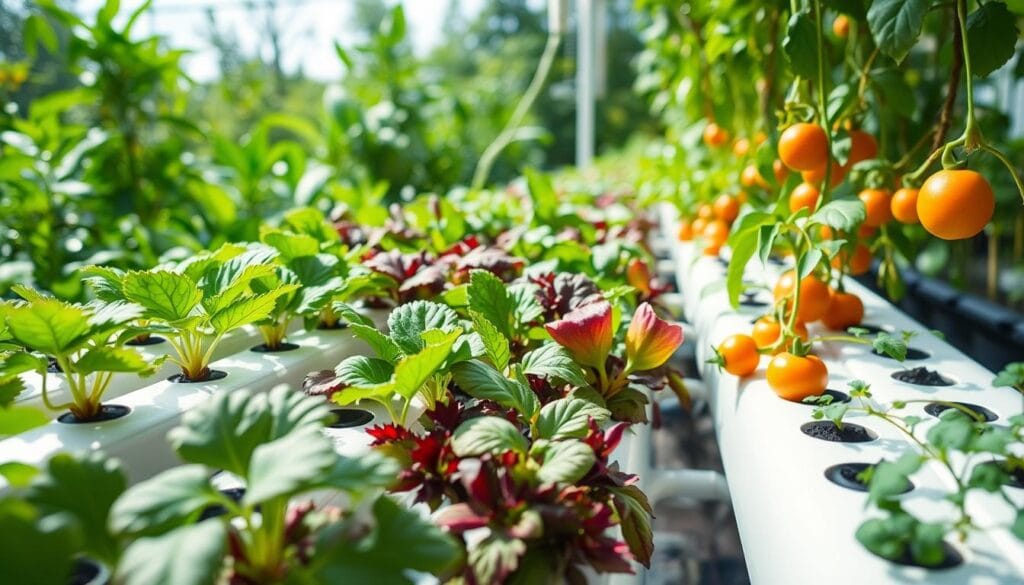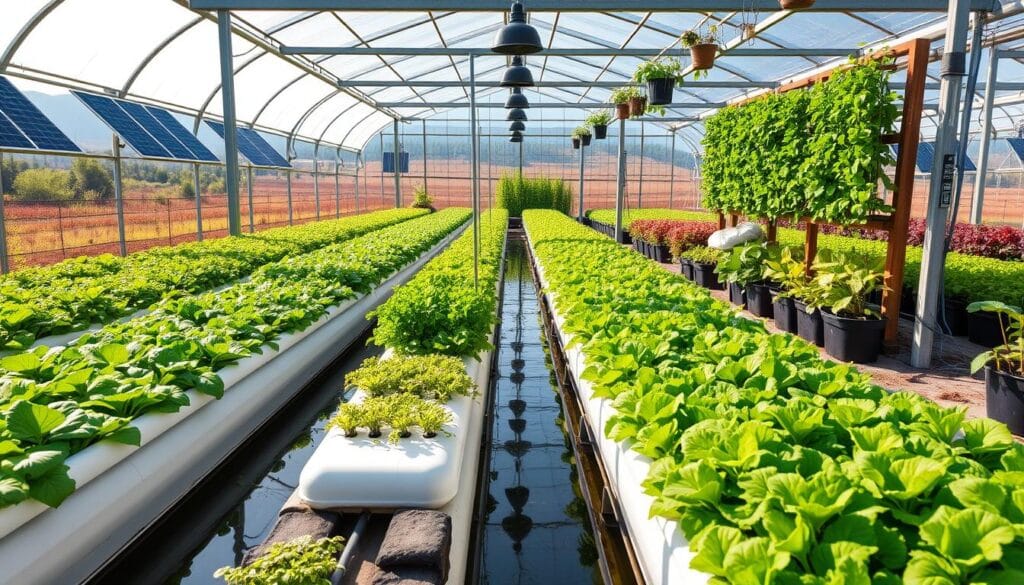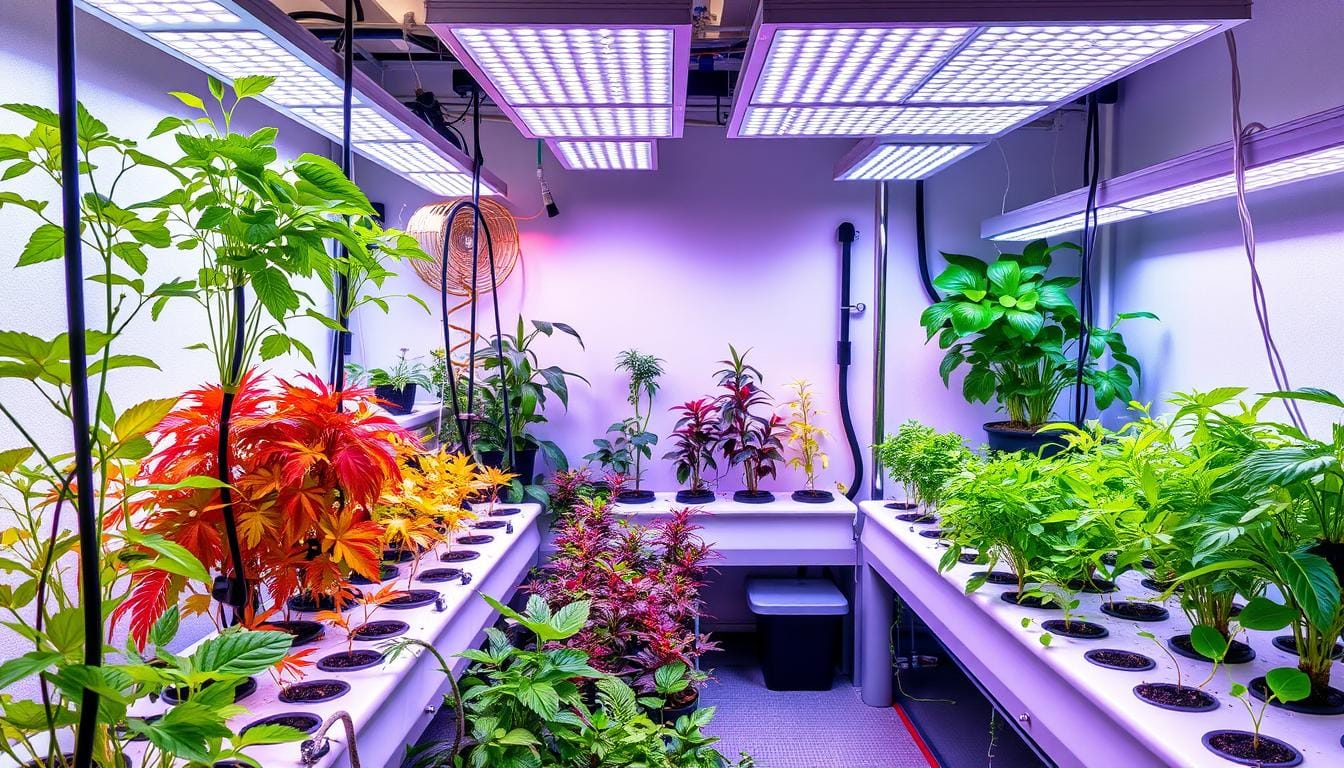Have you ever felt stuck because of a small garden space or poor harvests? The answer is the amazing hydroponics growing system, a revolutionary method that allows you to grow fresh, healthy food right at home.
Soilless cultivation is more than a trend; it’s a big change for city gardeners. It lets you grow veggies well and use much less water than old-school gardening.
Whether you’re new to gardening or have lots of experience, learning hydroponics opens up a world of possibilities. You’ll make a lively indoor garden that gives you fresh, safe food anytime you want.
Key Takeaways
- Maximize crop yield with water-efficient hydroponic techniques
- Create sustainable indoor gardens in limited spaces
- Reduce water consumption compared to traditional gardening
- Grow fresh, nutrient-rich vegetables year-round
- Eliminate pesticide risks with controlled growing environments
Understanding Hydroponics Fundamentals
Hydroponic systems are a new way to grow plants, unlike traditional soil-based methods. They use controlled environment agriculture to help plants grow better and faster. This method is very efficient.
Vertical farming has changed how we farm, making it better for cities. It lets you grow plants without soil. Instead, plants get what they need from nutrient-rich water.
Water-Based vs Medium-Based Methods
Hydroponic systems are mainly divided into two types:
- Water-Based Methods: Plants float in nutrient solutions
- Medium-based methods involve roots developing within substances such as clay pellets
“Agricultural Innovation Research states that hydroponic systems can reduce water usage by up to 90% compared to traditional gardening practices.
Essential Components Overview
Every aquaponic system needs a few key parts to work well:
- Nutrient reservoir
- Growing medium
- Irrigation system
- pH monitoring tools
Basic System Types
There are different hydroponic methods for different plants and places:
- Nutrient Film Technique (NFT)
- Ebb and Flow Systems
- Aeroponics
Knowing these basics helps you make a great growing space. It boosts plant health and yields while saving resources.
Setting Up Your Growing Environment
Creating the perfect indoor gardening setup is key.To ensure optimal plant growth, your hydroponic system must provide the appropriate conditions.
When setting up your indoor garden, keep these important points in mind:
- Temperature control (68-70°F ideal range)
- Humidity management (50-70% recommended)
- Air circulation strategies
- Lighting configurations
Temperature is very important for plant growth. Keeping the temperature steady helps plants grow well. Use digital thermometers to check your environment.
“According to the Vertical Farming Expert, maintaining strict precision is crucial for ensuring success in hydroponic farming.
Humidity affects how plants breathe and take in nutrients. Too much humidity can cause fungus, while too little can stress plants. Get a good hygrometer to keep an eye on humidity.
| Environmental Factor | Optimal Range | Impact on Plants |
|---|---|---|
| Temperature | 68-70°F | Supports steady growth |
| Humidity | 50-70% | Prevents disease/stress |
| Air Circulation | Continuous movement | Reduces pest risks |
Your indoor gardening plan should include good ventilation. Good air movement helps prevent pests and ensures plants grow evenly.
Successful indoor gardening means always checking and making small changes. Use climate control tech to keep your growing space stable all year.
Mastering Nutrient Management
Successful hydroponic growing needs precise nutrient management. Your plants’ health and growth depend on the right nutrients for your system.
Nutrient management in hydroponics is key. It requires careful attention to detail. The nutrient film technique needs a smart way to give plants what they need.
Macro and Micronutrient Balance
Plants need a specific mix of nutrients to grow well. Your hydroponic nutrients should include:
- Primary Macronutrients:
- Nitrogen (N)
- Phosphorus (P)
- Potassium (K)
- Secondary Nutrients:
- Calcium
- Magnesium
- Sulfur
pH Level Monitoring
Keeping the right pH is vital for nutrient absorption. Your system should keep pH levels between 5.5 and 6.5 for the best nutrient uptake.
| Nutrient Type | Recommended EC Level | Mixing Ratio |
|---|---|---|
| Week 1 Solution | 0.6 – 0.8 | 2.5 ml per gallon |
| Vegetative Stage | 1.2 – 1.8 | 3-4 ml per gallon |
| Flowering Stage | 1.6 – 2.2 | 4-5 ml per gallon |
Solution Mixing Guidelines
“Precision is key in hydroponic nutrient management. Every drop counts.”
Here are some tips for mixing your nutrient solution:
- Use powdered nutrients for cost-effectiveness
- Check electrical conductivity (EC) regularly
- Change nutrient solutions every 1-2 weeks
- Adjust nutrients based on plant growth stages
Pro tip: Invest in an automated dosing system. It makes nutrient management easier and saves time from 1 hour to just 1 minute.
Selecting the Right-Growing Medium
Choosing the perfect growing medium is key to successful hydroponic gardening. It affects plant health, nutrient absorption, and system performance. This is vital in soilless cultivation.
Different mediums have unique benefits for delivering hydroponic nutrients. Let’s look at the most popular ones:
- Rockwool: A top choice for commercial hydroponic systems
- 18-25% air volume promotes healthy root growth
- pH level ranges from 7.5-8.5
- Disease-resistant and sterile
- Coco Coir: Sustainable and versatile medium
- It has the capcity to retain up to ten times its own weight in water
- Provides excellent root aeration
- Environmentally friendly option
- Perlite: Lightweight and pH-neutral
- Requires frequent nutrient replenishment
- Provides excellent drainage
- Ideal for mixing with other mediums
| Growing Medium | Water Retention | Aeration | Best Use |
|---|---|---|---|
| Rockwool | Good | Excellent | Commercial systems |
| Coco Coir | Excellent | Very Good | Sustainable growing |
| Perlite | Low | Excellent | Drainage support |
“The right growing medium is the foundation of successful hydroponic cultivation.” – Hydroponic Expert
When picking a growing medium, think about water retention, nutrient delivery, and plant needs. Try out different mediums to find the best fit for your hydroponic strategy.
Hydroponics Growing System Equipment Essentials
Getting the right tools for your hydroponic garden can change your growing experience. The success of your indoor garden depends on choosing the right equipment. This equipment supports plant growth and makes your garden more efficient.
Setting up a strong hydroponic system needs careful picking of key parts. These parts work together well. From grow lights to monitoring tools, each piece is important for a great growing space.
Lighting Requirements
Grow lights are the core of indoor hydroponic systems. LED grow lights are very energy-efficient and can be set for different plant growth stages. When picking grow lights, think about these important factors:
- Spectrum range for different plant growth phases
- Energy consumption
- Heat generation
- Coverage area
Pumps and Irrigation Components
Good water circulation is key for delivering hydroponic nutrients well. Submersible pumps and air pumps make sure your plants get the right nutrition and oxygen.
- Submersible pumps for water circulation
- Air pumps to oxygenate nutrient solutions
- Reliable irrigation tubing
Monitoring Tools
Precision is important in hydroponic gardening. Get reliable monitoring tools to keep an eye on your system’s health:
- pH meters for nutrient solution balance
- EC (electrical conductivity) meters
- Digital timers for automated lighting
- Temperature and humidity sensors
“The right equipment transforms hydroponic gardening from a challenge to a streamlined, enjoyable experience.” – Hydroponic Gardening Experts.
By choosing the right hydroponic system equipment, you’ll make a space where plants can grow well with little help.
Plant Selection and Spacing Guidelines

Starting an indoor garden means picking the right plants for your vertical farm. Success comes from choosing crops that do well in hydroponics.
When picking plants for your hydroponic setup, think about these things:
- Growth rate
- Nutrient needs
- Space available
- How they handle light
Start with plants that grow fast in hydroponics. Leafy greens and herbs are great because they grow quickly and need little space.
“Choosing the appropriate plants can transform your hydroponic system into a flourishing garden.”
Here are some good plants for different hydroponic setups:
| Plant Type | Hydroponic System | Growth Difficulty |
|---|---|---|
| Lettuce | Nutrient Film Technique | Easy |
| Basil | Deep Water Culture | Easy |
| Cherry Tomatoes | Drip System | Moderate |
| Spinach | Wick System | Easy |
Spacing is key in vertical farming. Make sure each plant gets enough light, air, and nutrients. Use trellises for climbing plants to use your space better.
Keep an eye on your plants, tweak the nutrients, and be ready to try new things. Your indoor gardening journey is always learning.
Water Quality and Management
Keeping water quality high is key to a successful aquaponic system. Your hydroponic garden’s health depends on managing water well. This ensures plants grow well and absorb nutrients.
Water management in controlled environment agriculture needs a careful plan. It covers many important factors. Let’s look at the main steps to keep your hydroponic water clean.
Advanced Filtration Methods
Good water filtration is vital for removing harmful substances. This keeps plants healthy. Here are some top filtration methods:
- Reverse osmosis systems for ultra-pure water
- Carbon filtration to get rid of chlorine and organic impurities
- Sediment filters to catch tiny particles
Precise Temperature Control
Water temperature affects how plants absorb nutrients and their root health. Try to keep water between 65-75°F (18-24°C) for the best growth. Use special heaters or coolers to keep the temperature steady.
Oxygenation Techniques
Dissolved oxygen is essential for hydroponic systems. Use these methods to add oxygen:
- Air stones to add oxygen directly to the solution
- Venturi systems for better oxygen flow
- Water cascading to boost oxygen absorption
“The key to thriving hydroponic gardens is understanding and masterfully managing water quality parameters.” – Hydroponic Expert.
Testing water regularly and managing it well prevents problems. Focus on filtration, temperature, and oxygen. This will help your plants grow strong in your aquaponic systems.
Creating an Efficient Dutch Bucket System
Vertical farming has changed how we grow crops, thanks to soilless cultivation. The Dutch Bucket system is a key method for both home gardeners and commercial growers. It lets you grow more with less space and resources.
The Dutch Bucket system, also known as the Bato Bucket method, is great for growing vine crops like tomatoes, cucumbers, and peppers. It’s a top choice for vertical farming. It offers precise control over plant nutrition and growth, enabling optimal development and productivity.
Key Components of a Dutch Bucket System
- 2-5 gallon buckets for individual plant containers
- Growing media such as perlite or coconut coir
- PVC pipes for drainage and nutrient circulation
- Drip irrigation system
- Nutrient reservoir
“Hydroponic Experts explain that the Dutch Bucket system efficiently utilizes limited space, turning it into a productive growing area and making soilless farming more accessible to a wider audience.
Setting up your system needs careful planning. Arrange your buckets in rows and connect them with PVC pipes. This creates a network for nutrient delivery. The drip irrigation method ensures each plant gets what it needs for growth.
System Configuration Tips
- Choose buckets with proper drainage holes
- Select a growing medium that supports root development
- Install a reliable pump for nutrient circulation
- Monitor pH and nutrient levels regularly
- Adjust irrigation cycles based on plant requirements
Whether you’re a hobby gardener or scaling up your vertical farming, the Dutch Bucket system is efficient. Try different crops and setups to find what works best for you.
Sustainable Practices in Hydroponics
Sustainable hydroponics is a key part of modern farming. It uses new tech and cares for the environment. You can make a system that grows food well and doesn’t harm nature.

Starting your hydroponic journey can help the planet. Aquaponic systems are a great example. They mix being efficient with caring for the earth.
Energy Conservation Methods
It’s important to use less energy in hydroponics. Here are some ways to do it:
- Install LED grow lights with smart timers
- Use energy-efficient circulation pumps
- Implement solar panel power solutions
- Optimize greenhouse insulation
“Sustainability in hydroponics isn’t just about growing food—it’s about growing food responsibly.” – Agricultural Innovation Expert.
Water Recycling Techniques
Managing water is key to sustainable farming. Hydroponics can use a lot less water:
- Implement nutrient film technique (NFT)
- Utilize deep water culture (DWC) systems
- Develop closed-loop water recycling
- Monitor and adjust water quality regularly
Using these methods, you can make a hydroponic system. It can use 98% less water than old farming ways. This helps local food and protects the planet.
Troubleshooting Common Issues
Indoor gardening with hydroponics can face challenges that need careful attention. Knowing common issues helps keep your growing space healthy and productive.
When managing your hydroponic nutrients, watch for these critical warning signs:
- Leaf discoloration indicating nutrient deficiencies
- Stunted plant growth
- Unusual root development
- Unexpected pH level changes
Here are key strategies for addressing common hydroponics challenges:
- Pest Management: Implement integrated pest control techniques to prevent infestations
- Algae Prevention: Minimize light exposure to nutrient solutions
- Root Health: Improve oxygenation and maintain proper water temperature
| Issue | Symptoms | Solution |
|---|---|---|
| Nutrient Imbalance | Yellowing leaves | Adjust nutrient concentration |
| Root Rot | Brown, mushy roots | Enhance water circulation |
| pH Instability | Nutrient lockout | Maintain pH between 5.5-6.5 |
“Consistent maintenance is essential for preventing the majority of issues in a hydroponic system.”
By staying vigilant and performing consistent system checks, you can quickly identify and resolve problems in your indoor gardening setup.
Monitoring and Maintenance Schedule
Keeping a controlled environment and agriculture setup running well needs a good plan for checking and care. Your hydroponics system must get regular attention to keep plants healthy and the system working right.
Creating a detailed care plan is key for your hydroponic system’s long life and high output. By dividing tasks into daily, weekly, and monthly tasks, you can stay ahead and avoid problems.
Daily Checks: Ensuring System Stability
- Inspect plant health and look for signs of stress
- Monitor water levels and top up as needed
- Check pH levels (maintaining between 5.5 and 6.5)
- Verify water temperature (ideal range 65°F-75°F)
- Examine pump and lighting functionality
Weekly Tasks: System Optimization
- Clean system filters thoroughly
- Test and adjust nutrient solution levels
- Measure electrical conductivity (EC should be 1.0-2.5 mS/cm)
- Prune and trim plants as necessary
- Inspect for possible pest problems
Monthly Upkeep: Deep System Maintenance
| Maintenance Area | Action Items |
|---|---|
| System Cleaning | Deep clean all parts with a diluted vinegar solution |
| Nutrient Management | Replace the whole nutrient solution |
| Equipment Calibration | Recalibrate monitoring tools and sensors |
| Light Maintenance | Check to grow light performance and replace if needed |
“Consistent maintenance is crucial for the health and success of a thriving hydroponics system. Ignoring it can cause big problems with plant growth and system performance.”
Following this maintenance plan will help your controlled environment agriculture setup reach its full promise. It ensures healthy plant growth and stops system failures.
Conclusion
Starting your journey with hydroponics is a big step towards sustainable farming. It’s an innovative method for growing fresh and healthy food.
Indoor gardening lets you grow crops in a controlled space, which means better yields and less waste.
Hydroponics is good for the environment. It uses up to 50% less water and takes up less space. You can also grow food all super useful year-round.
Getting started might seem hard, but it’s worth it. New hydroponic kits make it easier to start. You can grow everything from greens to fruits, right in your home.
Hydroponics is not just for gardening anymore. It’s a peek into the future of farming. By learning and using these methods, you’re helping to make food production better for our planet.

